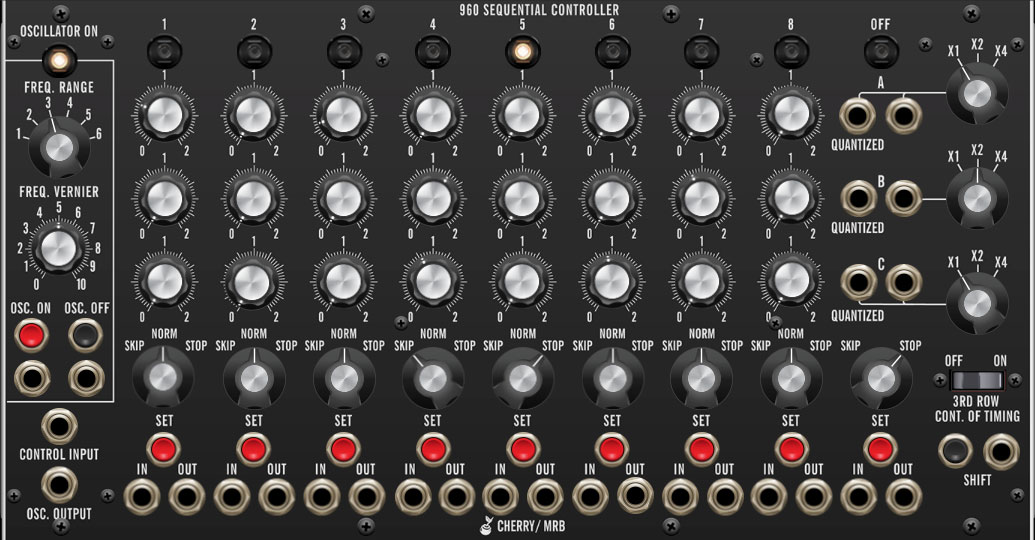The VM960 is a super-accurate reproduction of THE classic three-channel, eight-stage sequencer, famously used by Tangerine Dream, Kraftwerk, and a guy named Keith something or other. When combined with the VM962 Sequential Switch module, the eight-stage rows can run sequentially for 16- or 24-stage sequences.
For information on syncing the 960 sequencer to a host DAW, check out this swell video: https://youtu.be/fqasWvcVke4
Basic Operation
Each step comprises a vertical column with an indicator lamp, three CV knobs, a switch specifying stage behavior, a "manual" button to instantly jump to the step, and gate in and out jacks. When the internal oscillator is enabled, the sequencer plays through the steps from left to right according to each step's Skip/Normal/Stop selector, and outputs voltages to the jacks at the right of the panel according to CV knob settings. The CV's are most frequently patched to oscillator CV inputs for pitch control, but sequencer outputs can be patched to any CV-controllable module parameter, such as filter cutoff frequency, VCA amplitude, etc. Envelope generators can be gated using the onboard oscillator Control Out (i.e. clock) jack or via one of the Out jacks at each stage.
Since the onboard oscillator isn't used for audio duties, we'll refer to it as a "clock," to make it easier to understand its function.
Oscillator (Clock) Section
This is VM960's internal clock. When activated, this causes the sequencer to run through its stages. It has a range of 0.1-1000 Hz.
Oscillator On lamp- Glows when the oscillator is active - consider this a "play" light.
Frequency Range- Sets the clock oscillator speed is one-octave increments.
Frequency Vernier- Fine tunes clock speed, and has a fancy name... say it out loud, it's fun!
Osc. On/Osc. Off buttons- Activates the clock oscillator. Basically these are play and stop buttons, respectively.
Osc. On/Osc. Off CV inputs- Allows starting and stopping of the clock via gate or trigger CV's.
Control Input- Allows CV control of clock oscillator frequency. The oscillator and Control Input are calibrated to the 1V/oct standard, allowing VM960 to be used as a complex oscillator when played at audio rates.
Oscillator Output- Pulse wave CV output of the oscillator.
Sequencer Stage Controls
There are nine sequencer stages - eight standard stages, and one special "stop" stage. We'll go over the controls for the eight standard steps first:
Stage Active lamp- The stage lamp illuminates to show the current stage is active.
Row 1/2/3 CV knob- Sets the DC voltage for the stage. Depending on the current setting of the Voltage Range knob at the far right, the range for each stage will be 0-2V, 0-4V, or 0-8V. Since Voltage Modular follows the 1V/oct standard, this translates to two, four, or eight octaves.
Skip/Normal/Stop selector- Defines the behavior for each stage when playback "arrives" at the stage as follows:
Skip- Immediately jumps to the next stage.
Normal- Outputs the voltages as defined by the CV knobs for the current clock duration.
Stop- Inhibits shifting to the next stage (clock oscillator will remain on though).
Set- Instantly jumps to the stage when pressed (regardless of whether the internal clock is running).
In CV jack- Instantly jumps to the stage when a gate or trigger voltage is received.
Out CV jack- Outputs a gate voltage as long as the stage is active.
Stage 9 (Off)
This stage defines VM960's behavior following stage 8, depending on the the setting of its Skip/Stop selector. We'll go over the controls from top to bottom again, as they're a little different from a standard stage.
Stage Active (Off) lamp- The stage lamp illuminates to indicate the sequence is currently at the "stop" step.
Skip/Stop selector- Defines the stage 9 behavior as follows:
Skip- Following stage 8, the sequence immediately returns to stage 1 for continuously looping playback.
Stop- Following stage 8, the clock is stopped and sequence playback stops.
Set- Instantly jumps to stage 9 when pressed (regardless of whether the internal clock is running).
In CV jack- Instantly jumps to stage 9 when a gate or trigger voltage is received.
Out CV jack- Outputs a gate voltage as long as stage 9 is active.
The In/Out CV jacks can be used to create sequence patterns less than 8 steps by patching the output of the desired last stage to the desired first stage. For example, to create a six-step sequence, patch stage 7 Out jack to stage 1's In jack.
Right-Side Controls and Jacks
Row A/B/C CV Out Jacks- Each row has two corresponding CV out jacks. On the original 960, the output signals were identical, but we've taken the liberty of making the left jack a 1/2 step (volt) quantized output. This greatly simplifies the creation of diatonic and chromatic melodies. The right jack is not quantized; this is likely more useful for non-melodic CV purposes, such as filter cutoff frequency or amplitude modulation.
Row A/B/C X1/X2/X4 Range selectors- Selects the voltage range for the each horizontal row of CV knobs as follows:
X1- 0-2V
X2- 0-4V
X4- 0-8V
3rd Row Control Of Timing- This hard wires row C's non-quantized output to the clock oscillator's Control Input jack. If the CV knob is set to zero, clock frequency will not be affected; every volt will double the oscillator frequency.
Shift button- Pressing this advances to the next stage (with the internal clock on or off).
Shift jack- Advances the sequence to the next stage when a trigger or gate voltage is received, with internal clock on or off. If the clock is off, the shift jack is useful as an external clock in, using any kind of repeating oscillator or LFO (we recommend something with a hard edge, such as a pulse or sawtooth wave). With the clock enabled, shift jack will cause the sequence to "jump," which may or may not be useful depending on how crazy you want to get with sequence timing.
